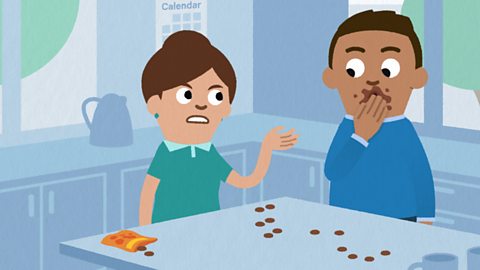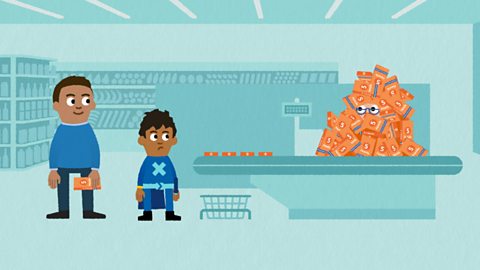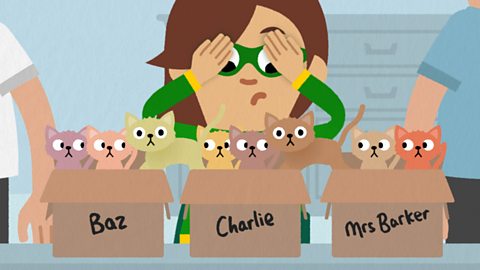Voiceover:
In a world without maths,a land where people forgot, who will save the day?
Narrator:
Whether multiplying or dividing, skills like counting in twos, fives and tens are vitally important. Today we get a rare glimpse, behind the scenes to find out how Multiplication Boy and Divider Girl train. Keeping their super powers sharp takes work. Armed with their hundred grids they compete head to head in a secret mission, to see who can count the highest in multiples. It’s training time!
(Three Beeps)
Narrator:
Round one, counting in twos.
Narrator:
Divider Girl is the first one to stop. She’s looking for something that comes in twos.Good thinking Divider Girl, rabbits’ ears. Let’s see how many there are.One 2 is 2, two 2s equal 4, three 2s are 6, four 2s that’s 8…I think that’s your lot Divider Girl.Checking to make sure all the numbers are even?
Let’s see how Multiplication Boy’s getting on. Multiplication Bo…? Oh. Ahh, Multiplication Boy is countingsocks. Let’s see what he’s got. Every number in the two times table is even. How high can we go?
One 2 is 2, two 2s are 4, three 2s are 6, four 2s are 8, five 2s are 10, six 2s are 12, seven 2s are 14, eight 2s are 16, nine 2s are 18, ten 2s are 20! Wow, let’s check thepattern. 2, 4, 6, 8, 10, 12, 14, 16, 18, 20. All even numbers and no odd ones. Excellent, that looks good to me.Multiplication Boy wins round one.
Round two, counting in fives.
Looks like Multiplication Boy’s got a plan, but what’s he up to?Counting toes, that’s a great idea. How many can he find? One 5 is 5, two 5s are 10, three 5s are 15, four 5s are 20 he’s on a roll, five 5s are 25 anymore?..six 5s are 30…that’s all the toes in this pool.Great work. Let’s find Divider Girl.
Here she is but what’s she up to?..She’s not doing anything. Come on Divider Girl, Multiplication Boy’s going to win.Oh smart move! She’s counting fingers and thumbs.
One 5 is 5, two 5s are 10, three 5s are 15, four 5s are 20, five 5s are 25, six 5s are 30, seven 5s are 35, eight 5s are 40, nine 5s are 45, ten 5s are 50.
How does the pattern look? For multiples of 5 the answer ends in 5 or 0. So the pattern reads 5, 0, 5, 0, 5, 0 and so on.Wow she’s nailed it. Divider Girl wins round two.
Round three, counting in tens.
One 10 is 10.
Two 10s are 20.
Three 10s are 30.
Four 10s are 40.
Hang on, what’s going on…oh my, wow, they’re both counting the same thing, this is going to be close.Five 10s are 50, six 10s are 60.
Seven 10s are 70, eight 10s are 80, nine 10s are 90.
Mrs Barker:
Oh now where’s that barcode gone? This is a tricky one…Are you sure you want this? You’ve got quite a lot already…oh here it is.
Narrator:
Ten 10s, one hundred!
They’ve both won, woohoo!
Don’t forget to check the pattern, do they all end in zeros? 10, 20, 30, 40, 50, 60, 70, 80, 90, 100. Well done.Time to put that training into action you two, somebody needs your help.
Video summary
Multiplication Boy and Divider Girl keep their maths superpowers sharp with a competition to count in twos, fives and tens.
Looking around the world, they count objects that come in multiples.
Spotting patterns in the times tables, they race against each other to win the competition.
These maths heroes know that counting in multiples helps with multiplying and dividing.
But who has got the speediest skills? Let’s find out!
This clip is from the series A World Without Maths.
Teacher Notes
Children might use objects or pictures to count in twos, fives and tens.
They could go outside and look for objects that appear in twos, fives or tens, or gather things to create groups of twos, fives and tens (leaves, sticks, pebbles)
They might arrange the objects in groups or arrays and label each group with the multiplication calculation.
This might be extended for some children to begin to explore the inverse division calculations.
Children could identify the multiples of two, five or ten on a number line, in a hundred square or on a multiplication grid.
They might fill in missing multiples in a sequence. Then, begin to look for patterns in each set of numbers.
This clip will be relevant for teaching Maths at KS1 and KS2 in England and Wales, and First and Second Level in Scotland.
How to use mental methods to multiply. video
Mr and Mrs Sharma can’t work out how many sausages to buy for a party, so they try to count using chocolate buttons, but are getting into a right mess!

How to use arrays to multiply. video
Multiplication Boy helps Mr Sharma buy pencils for the school, using arrays to multiply.

What is multiplication? video
Multiplication Boy uses repeated addition to help Dave work out how many bricks he needs to build a new wall for Mrs Sharma.

The relationship between multiplication and division. video
Baz and Dave use division and multiplication to solve a tricky problem with kittens.

Dividing using repeated subtraction. video
Divider Girl uses repeated subtraction to help Mrs Barker with a division problem involving some hungry pups.

How to use mental methods to divide. video
Divider Girl helps Charlie with a division problem, using her multiplication facts.
